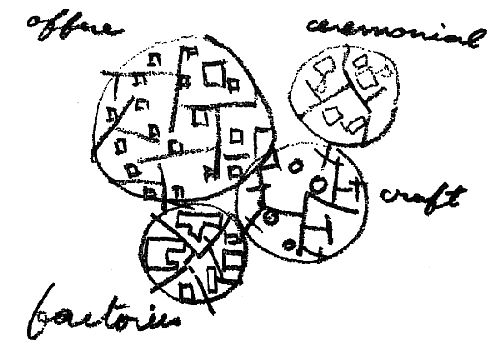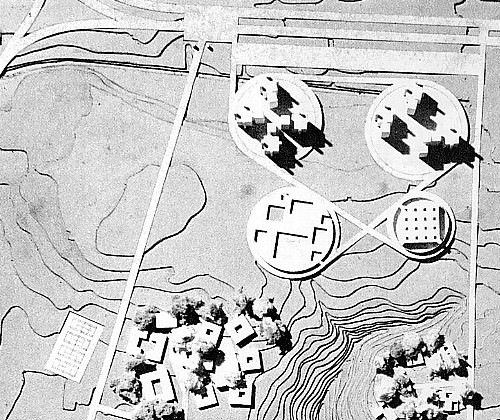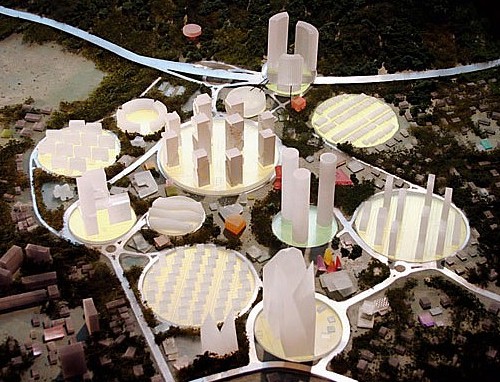2001.01.14
More Tedious Stuff (Design Process Type)
Paul states:
This is where the "function" enters the genesis of the parti. Kahn spoke of "served" and "servant" spaces, of course. The secondary spaces are not "celebrated," but become embedded in "conceptual poché," which the parti diagrams as solid, leaving only the celebrated, or publicly experienced, spaces as "spatial figure." The figure-ground gestalt is fundamental to this basic design strategy, applied to urban design by Colin Rowe and his school, but derived from Beaux Arts practice.
Steve replies:
I don't see Paul's capsulation of Kahn's notion of "served" and "servant" spaces as altogether correct. Rather, it is more of a (convenient) pedagogical interpolation based on a hybridization of "served and servant" (Kahn) with "figure/ground" (Rowe). Two of Kahn's buildings that most manifest the "served" and "servant" notions are the Richards Medical Research Building (Philadelphia, 1957-60) and the Salk Institute (La Jolla, 1959-65). In both designs the "served" and the "servant" are each clearly articulated, and one could go so far as to say that it is more the articulation of the "servant" spaces that manifest the "served" spaces. Neither of these two buildings employs what might be described as poché.
I now wonder whether Paul's interpolation exemplifies a wider ranging interpolation throughout architectural academia since Kahn's practice, hence a not necessarily true interpretation /proliferation of Kahn's message /meaning vis-à-vis "served" and "servant". The notions of "served" and servant" are first to be applied to the program, i.e., the building program is divided into those spaces that serve and those spaces that are served. The form of the building then arises out of the articulation of both the "served" and the "servant", and the ultimate design is the integration and/or inter-relation of the two types of "spaces".
Perhaps the only slanted aspect of Kahn's notion of "served" and "servant" spaces is the underlying notion that some spaces are privileged while the other spaces are not privileged. And perhaps this is precisely where the misinterpretation of "served" and "servant" actually comes from. In reality, however, Kahn somehow managed to "privilege" virtually all the spaces of his buildings. [And perhaps it can be said that Kahn was therefore very good at working the mediocre.]
Just now I'm wondering whether the grammatical terms of "active" and "passive" might be an interesting extension of the served and servant notions, i.e., with served being the passive and the servant being the active. It might be interesting to sometimes analyze buildings by identifying those parts/spaces that are active (doing the acting) and those parts that are passive (being acted upon). This point of view might help alleviate the "privilege" factor.
| |
2002.08.11 13:23
Re: Kahn and Wright
Second, I agree with what you say about the nixing of Giurgola's design additions to Kahn's buildings (Kimbell and Salk). In reading the recent New Yorker article on Serra, I was reminded of how much I enjoyed the controversy over Tilted Arc as it unfolded. I am no advocate of the notion that so-called site specific art is somehow 'above it all.' Time and the changes it brings is one reality that I believe no one can prove or demonstrate to be otherwise. I rather enjoy seeing, documenting, and learning from the changes that come with time. In the early nineties I thought it would be fun to make a cad model of the Federal Building with Tilted Arc, an idea that fit well with what became Quondam.
Seeing the other day how Ahavath Israel Synagogue is now again changed was like a gift to me in that I was there looking because I'm working on Somewhat Incompletely Louis I. Kahn. I'm beginning to believe that the notion of incompleteness is exactly what's missing from design theory, teaching and practice, and, indeed, that an understanding of incompleteness could help remedy at least some of what you see as being so wrong today.
In the radio interview of Hani Rashid (that Brian told us about), just over 13 minutes into the interview Rashid said, "There is a famous adage by Louie Kahn that really one doesn't get to build until they're in their early fifties." I'm not sure where this adage comes from exactly, nor if that is indeed what Kahn really said, but the reality is that Kahn (who turned 50 in 1951) had already build a whole lot of buildings between 1935 and 1951. Kahn's work, however, did not receive wide recognition until the Yale Art Gallery (1950-53) and then (for the buildings) after. [Another thing Rashid said is that his firm never expected their Virtual New York Stock Exchange project to receive all the recognition it did, which completely contradicts what Rashid said at the Anything conference (June 2000 I think), that is, that he pretty much demanded the clients of the project to publicize it!)
If I am ever commissioned to design and execute a building that's not virtual, I know full well that I could never do it all on my own, thus I'd employ and justly acknowledge the work of others. I kind of do that already when I publish the letters of others at Quondam and Museumpeace. The point being that often what I write is indeed intertwined with what others have also written. The only dilemma in that is if I package these texts for commercial sale, then I might also be infringing the copyright of other's intellectual property. [I'm still working on figuring out a good design for remedying that.]
Seeing the Trenton Bath House for the first time last week while it was very much being used, more or less convinced me that Kahn indeed learned (and then knew) a whole lot about architecture, particularly architecture's osmotic potential--that place's integration of outside and inside is nothing less than a "breath of fresh air."
| |
2005.03.15 12:15
Re: facadism
I liked the images of the Henry Miller too. I can understand the ire at what these 'false' facades represent, as well. Nonetheless, the images (for me at least) evoke memories of the free standing, screen facades that Mitchell/Giurgola Architects incorporated into a fair numbers of their designs mostly during the 1970s (--John, I'm sure you know the M/G building at Columbia U., got any tales to tell?), and I'll collect what images I have and publish them at Quondam soon. I think the immediate precedent for this practice was Kahn's notion of "wrapping ruins around buildings," which (I think) was said in regard to the Library at Exeter (1965-72), but it may have been said in reference to the Meeting House at Salk (1961-62, unexecuted) or even the US Consulate, Luanda, Angola (1959-62, unexecuted).
2006.05.10 19:26
Depth
Louis I. Kahn, Yale University Art Gallery, 1951-53.
Louis I Kahn and Anne Tyng, City Tower Project, 1952-57.
The geometric studies of Kahn and Tyng from 1951 to 1957 may have a strong bearing on "depth" as per the initial post/query of this thread.
Louis I. Kahn, Jewish Community Center (Trenton Bath House), 1954-59.
Colin Rowe and Robert Slutzky, Transparency: Literal and Phenomenal, written 1955-56.
Louis I. Kahn, Salk Institute for Biological Studies (Meeting House with volumetric cutouts, 1961), 1959-65.
Colin Rown and Robert Slutzky, Transparency: Literal and Phenomenal. first published in Perspecta, 1963.
2012.03.24 09:20
Re: Traditional Architecture
In preparation for a forthcoming Quondam exhibition of "The Philadelphia School," just yesterday I began (re)reading Scully's Louis I. Kahn (1962) where we see Kahn's early 1920s Beaux Arts architectural education being somewhat of a hindrance during the 1930s and 1940s, but then significantly informing the beginnings of his mature design work from the 1950s onward. And, by the late 1950s we begin to see the influence of Piranesi's Ichnographia Campus Martius, e.g. First Unitarian Church, scheme 1, 1959; Salk Institute Meeting House, 1959; Bristol Town Hall, 1960.
| |
2012.07.11 13:33
The Philadelphia School, deterritorialized

Alison Smithson, Patterns of association - Each district with a different function, 1953.

Louis I. Kahn, Salk Institute for Biological Studies, first design phase, 1959-60.

OMA, Penang Tropical City, 2004.
Patterns of association, indeed.
|